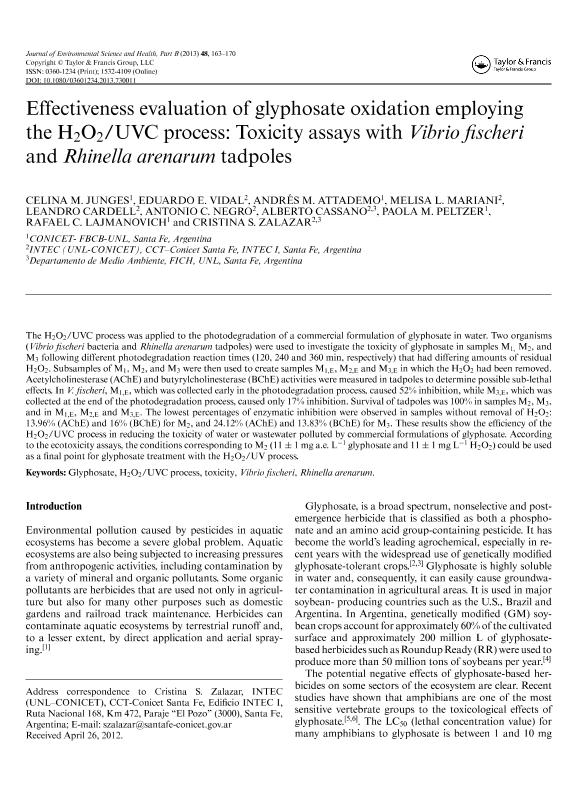Artículo
Effectiveness evaluation of glyphosate oxidation employing the H2O2/UVC process: Toxicity assays with Vibrio fischeri and Rhinella arenarum tadpoles
Junges, Celina Maria ; Vidal, Eduardo Gabriel
; Vidal, Eduardo Gabriel ; Attademo, Andres Maximiliano
; Attademo, Andres Maximiliano ; Mariani, Melisa Lourdes
; Mariani, Melisa Lourdes ; Cardell, Leandro; Negro, Antonio Carlos
; Cardell, Leandro; Negro, Antonio Carlos ; Cassano, Alberto Enrique
; Cassano, Alberto Enrique ; Peltzer, Paola
; Peltzer, Paola ; Lajmanovich, Rafael Carlos
; Lajmanovich, Rafael Carlos ; Zalazar, Cristina Susana
; Zalazar, Cristina Susana
 ; Vidal, Eduardo Gabriel
; Vidal, Eduardo Gabriel ; Attademo, Andres Maximiliano
; Attademo, Andres Maximiliano ; Mariani, Melisa Lourdes
; Mariani, Melisa Lourdes ; Cardell, Leandro; Negro, Antonio Carlos
; Cardell, Leandro; Negro, Antonio Carlos ; Cassano, Alberto Enrique
; Cassano, Alberto Enrique ; Peltzer, Paola
; Peltzer, Paola ; Lajmanovich, Rafael Carlos
; Lajmanovich, Rafael Carlos ; Zalazar, Cristina Susana
; Zalazar, Cristina Susana
Fecha de publicación:
06/2013
Editorial:
Taylor & Francis
Revista:
Journal of Environmental Science and Health. Part B: Pesticides, Food Contaminants, and Agricultural Wastes
ISSN:
1532-4109
Idioma:
Inglés
Tipo de recurso:
Artículo publicado
Clasificación temática:
Resumen
The H2O2/UVC process was applied to the photodegradation of a commercial formulation of glyphosate in water. Two organisms (Vibrio fischeri bacteria and Rhinella arenarum tadpoles) were used to investigate the toxicity of glyphosate in samples M1, M2, and M3 following different photodegradation reaction times (120, 240 and 360 min, respectively) that had differing amounts of residual H2O2. Subsamples of M1, M2, and M3 were then used to create samples M1,E, M2,E and M3,E in which the H2O2 had been removed. Acetylcholinesterase (AChE) and butyrylcholinesterase (BChE) activities were measured in tadpoles to determine possible sub-lethal effects. In V. fischeri, M1,E, which was collected early in the photodegradation process, caused 52% inhibition, while M3,E, which was collected at the end of the photodegradation process, caused only 17% inhibition. Survival of tadpoles was 100% in samples M2, M3, and in M1,E, M2,E and M3,E. The lowest percentages of enzymatic inhibition were observed in samples without removal of H2O2: 13.96% (AChE) and 16% (BChE) for M2, and 24.12% (AChE) and 13.83% (BChE) for M3. These results show the efficiency of the H2O2/UVC process in reducing the toxicity of water or wastewater polluted by commercial formulations of glyphosate. According to the ecotoxicity assays, the conditions corresponding to M2 (11 ± 1 mg a.e. L−1 glyphosate and 11 ± 1 mg L−1 H2O2) could be used as a final point for glyphosate treatment with the H2O2/UV process.
Palabras clave:
Glyphosate
,
H2o2/Uvc Process
,
Toxicity
,
Rhinella Arenarum
,
Vibrio Fischeri
Archivos asociados
Licencia
Identificadores
Colecciones
Articulos(CCT - SANTA FE)
Articulos de CTRO.CIENTIFICO TECNOL.CONICET - SANTA FE
Articulos de CTRO.CIENTIFICO TECNOL.CONICET - SANTA FE
Articulos(INTEC)
Articulos de INST.DE DES.TECNOL.PARA LA IND.QUIMICA (I)
Articulos de INST.DE DES.TECNOL.PARA LA IND.QUIMICA (I)
Citación
Junges, Celina Maria; Vidal, Eduardo Gabriel; Attademo, Andres Maximiliano; Mariani, Melisa Lourdes; Cardell, Leandro; et al.; Effectiveness evaluation of glyphosate oxidation employing the H2O2/UVC process: Toxicity assays with Vibrio fischeri and Rhinella arenarum tadpoles; Taylor & Francis; Journal of Environmental Science and Health. Part B: Pesticides, Food Contaminants, and Agricultural Wastes; 48; 3; 6-2013; 163-170
Compartir
Altmétricas



